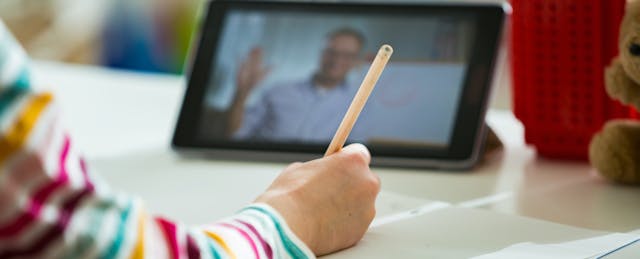As I sat in front of my iPad waiting for Jackson to join our second weekly one-to-one Zoom meeting, I wondered what would become the focus of today’s catch up. Earlier in the week, his classmate Jennifer confided that she was not feeling comfortable with the recent math assignments, so we spent her 25 minutes reviewing math problems. Ned and I spent the bulk of our time discussing how Tom Brady being traded to the Tampa Bay Buccaneers was the greatest thing to happen for football.
Whether reviewing concepts or talking sports, the one-to-one meetings I’ve had with students over the last eight weeks have proven to be the most impactful way to build our classroom community through the transition to remote learning.

When Jackson’s face appeared, I asked him how he felt about the hasty transition from our physical classroom to our remote learning environment. “The school part of this is OK, but what I really miss is playing with my friends,” he admitted. At that point, it became clear that the classroom community we intentionally crafted together in our physical classroom hadn’t translated to the virtual one yet. Jackson missed the emotional connection we had developed in our close-knit classroom. I knew we needed to continue the social-emotional work that we started in August—but we’d have to get creative now that we’d lost our physical classroom.
In the beginning of the school year, I made some significant changes to my instructional approach. Influenced by Marc Brackett’s book, “Permission to Feel,” I explored how emotions could directly impact student achievement and I started using Sanford Harmony, a social-emotional curriculum rooted in research about building a caring community that empowers students to be their best selves.
As a class community, we learned the importance of finding commonalities and building friendships. I started encouraging my fourth graders to honor their emotions before engaging in academic work and modeling how to do it. Students spent time learning how to name their emotions and considering which ones would help our classroom community thrive, and they became self-aware enough to recognize when they were frustrated and reframe their frustration so they could engage in learning.
Using the Sanford Harmony curriculum, we explored ineffective communication behaviors, or “communication bloopers,” such as interrupting, withdrawing and ignoring, and effective communication strategies, or “communication boosters,” which include listening, supporting and negotiating. During a small group math activity, I overheard Ned telling his group what great ideas they had and praising them for how well they were supporting each other. During another lesson, Jennifer was able to communicate to her group members that they need to be less withdrawn and really focus on the lesson they were supposed to complete.
Marc Brackett’s book guided me to rethink the way I was approaching social-emotional learning with students. In his book, Brackett writes that “...how students feel is what gives meaning to what they are learning...emotions determine whether academic content will be processed deeply and remembered.” Connecting emotions to learning has helped me develop more relevant lessons, and taking the time to help students understand the range of emotions they feel, while empowering them with strategies to change their emotions, completely transformed my instruction. I held weekly one-to-one meetings with each student from the first day of school and over the course of the next three months, I noticed higher test scores and less behavior refusals.
But the last eight weeks have been taxing. I’ve been scrambling since late March when the educational system was turned completely upside down by COVID-19. No stakeholder was left untouched. Parents, students, administrators and teachers have all been trying their best to navigate the transition to remote learning, but it’s complicated. There are some elements of great teaching practice like building relationships and providing meaningful feedback that never change—not even when you lose your classroom. But some elements are so hard to replicate in an online learning environment.
Since our school closed, I’ve had to come up with ways to continue building the sense of community that once allowed all of my students to experience personal successes, not just academically, but socially and behaviorally as well. Whole group meetings have been a key feature of my remote learning plan. This communal time provides opportunities to discuss how each member of our class is doing. We continue to use Sanford Harmony to guide our meetings and practice the communication skills learned earlier in the year and we carve out time to learn how to encourage each other in our new virtual learning space. But clearly that’s insufficient.
Meeting Students’ Needs
Research shows that developing a strong relationship with each child is critical to student success and showing empathy to each student is a key element of relationship-building. When I saw students every day, it was easier to carve out small moments of interaction with each of them. But without my physical classroom, it has become something that needs to be scheduled.
Given the amount of uncertainty that many students and families face, I decided that even if I couldn’t commit to a daily connection with each individual learner, the best way to continue growing our classroom community was to schedule weekly one-to-one meetings.
While these meetings take up a large portion of my time during any given week, they have become the most powerful way that I can meet each student’s needs. Students also like these meetings. Some bring a pet and spend their time telling about what their pet has been up to. Others want to share how much they miss school or how much they appreciate being able to go through work at their own pace.
The structure of our virtual one-to-one meetings is the same as our in-person check-ins. I ask the student how they are feeling, if they have any questions about their assignments and if anything is new since the last time we spoke. On one occasion, I noticed that Jonathan had gotten a “quarantine cut”, and asked him about it. He laughed and told me that his dad had gotten a pair of clippers and decided to give them a try. He was not happy with the outcome.
Many things have changed since we’ve gone remote. Test scores may not be the final say when it comes to measuring success. I care more about how students and families are coping day-to-day, recognizing that students may not be able to complete work at the same level they once did. But one thing that has remained the same is that the relational connection between students and teachers is still one of most powerful human connections that exists.
Looking forward to next year, I intend to keep exploring how identifying emotions and building a classroom community can help students’ be their best selves, both academically and socially. And one-to-one meetings will continue weekly, whether in-person or online.
As my virtual meeting time with Jackson came to an end, I had to ask, “You know the feeling of the classroom community that we had in our regular classroom? How do you think we have done recreating that?” Jackson took a second to think and then responded, “You know, I think we are doing OK. I can see my friends during our meetings and I get to see their work. I like being able to ask you questions, if I have any during our meetings. I kind of like this remote learning stuff.”
For Jackson to admit that he “kind of likes this remote learning stuff,” is a success. For Jennifer to ask for unsolicited help during a series of math assignments is also a success. It’s why I firmly believe setting up our weekly one-to-one meetings was the best remote learning decision I have made.


